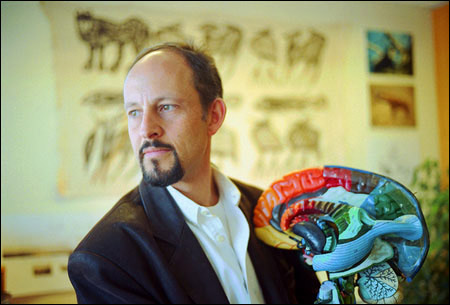Monkeys unable to master grammar crucial to language
Nonhuman primates appear capable of understanding only very basic grammatical structures

Nonhuman primates are unable to grasp a fundamental grammatical component used in all human languages, researchers at Harvard University and the University of St. Andrews in Scotland reported recently in the journal Science. Their work provides the clearest example to date of a cognitive bottleneck during the evolution of human language, suggesting a sharp limit to animals’ capacity to generate open-ended communication and possible restrictions on other domains of thought.
“There is no doubt that human communication is fundamentally different from that of other animals; the key question is, what computational, conceptual, motor, and sensory systems have evolved to create this difference?” says Marc D. Hauser, professor of psychology and Harvard College Professor. “The ultimate goal of our studies is to figure out what things changed and what things stayed the same over the course of primate evolution, and to help pinpoint areas of convergence and divergence.”
Grammar is essentially a system of rules for taking a finite set of discrete elements and combining them into a limitless range of novel expressions. For humans, grammar cobbles together words to create sentences. There is no evidence that animals have a similar system to produce sequences of calls with more expressive meaning.
Together with W. Tecumseh Fitch of the University of St. Andrews, Hauser exposed cotton-top tamarins to two novel grammars based on patterns of meaningless syllables – such as ba la tu li pa ka – spoken by a male and female speaker. The grammars differed only in the order in which the male and female voices alternated. The simpler language structure featured strictly alternating male and female voices (MFMF). The more powerful grammar used more complicated patterns such as multiple female voices followed by multiple male voices, such that a pair of male and female voices could be embedded within other voices (e.g., M[MF]F, F[FM]M, [M[M[MF]F]F]).
Following this initial exposure, the tamarins heard a series of recordings, some of them violating the rules of Hauser and Fitch’s grammars. When the animals perceived such inconsistencies, they tended to glance toward the speaker piping out the sounds, a behavior often used as an indicator of novelty detection in studies involving both animals and infants. Based on the percentage of the time the tamarins looked to the speakers, Hauser and Fitch determined that the animals were able to perceive violations of the simpler grammar but did not take note of infractions involving the more complex grammar.
“The tamarins probably don’t understand explicitly the rules of these grammars we created,” Hauser says. “They’re likely distinguishing between familiar and unfamiliar sound sequences, responding more to the unfamiliar or unexpected.”
Researchers have known for some time that animals can extract relatively abstract rules, such as those underpinning the weakest grammars. But Hauser and Fitch’s work suggests that tamarins are only able to comprehend simple associations of word pairs, and cannot process grammars where words fall outside this rigid pattern, or where related words are not adjacent.
“This work will greatly refine our understanding of what has changed over evolution, and suggest possible hypotheses concerning the selective pressures that led to such changes,” Hauser says. “Our finding may also refocus investigations of infant development and when different capacities develop during language acquisition, and could yield benefits for linguists seeking insights into the universal toolkit underlying all languages.”
Hauser and Fitch’s work is supported by the National Science Foundation, the National Institutes of Health, and the McDonnell Foundation.




